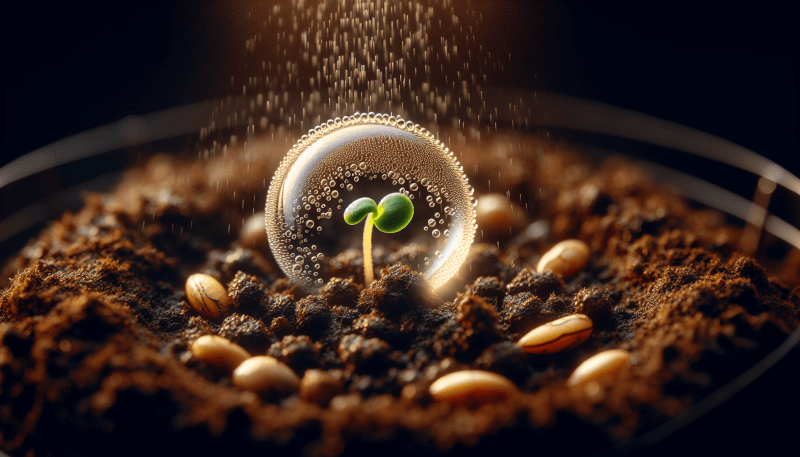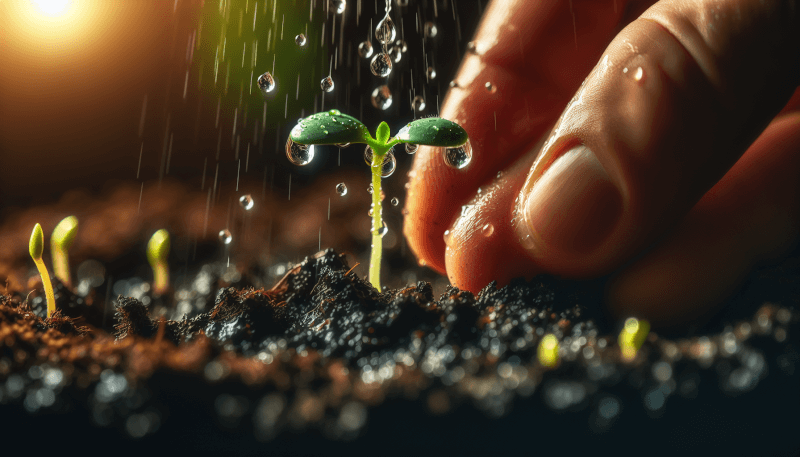👋 Click the mic button to talk to Alfred, the Todd's Seeds Gardening/Sprouting Expert – Feel free to ask him anything!
Ask Virtual Todd Anything - Click the Mic
Have you ever wondered how much water is needed to successfully germinate seeds? This article explores the importance of water in the germination process and provides insights into the appropriate amount of water required for optimal seed growth. Whether you’re a seasoned gardener or a beginner, understanding the water needs of germinating seeds is essential for cultivating healthy and thriving plants. So, let’s uncover the secrets to ensuring your seeds receive just the right amount of water to sprout and flourish into beautiful plants.

Factors Affecting Germination
Temperature
Temperature plays a crucial role in seed germination. Most seeds require a specific temperature range for successful sprouting. If the temperature is too low, the seeds will remain dormant; if it is too high, the seeds may be damaged or dried out. It is important to provide the appropriate temperature conditions for the specific type of seed you are germinating.
Light
Light requirements for germination vary among different plant species. Some seeds require complete darkness to germinate, while others need light exposure. It is important to research the light requirements of the specific seeds you are germinating to ensure optimal conditions for germination.
Oxygen
Just like any other living organism, seeds need oxygen for respiration. Oxygen is required for the metabolic processes that allow the embryo to grow and develop. Good airflow and oxygen availability are crucial for successful seed germination. Proper ventilation and avoiding overly compacted soil can help ensure that the seeds receive an adequate supply of oxygen.
Seed Quality
The quality of the seeds used for germination is another factor that can affect the success of germination. Fresh, healthy seeds have a higher chance of sprouting compared to old or damaged seeds. It is recommended to obtain seeds from reliable sources and to store them properly to maintain their viability. Additionally, proper storage conditions can prevent fungal or bacterial infections that may hinder germination.
Water Requirements for Germination
Importance of Water
Water is essential for seed germination as it initiates the metabolic processes that break dormancy and trigger growth. Without water, seeds cannot absorb nutrients or activate the enzymes necessary for germination. Adequate water supply ensures the availability of necessary nutrients and creates a suitable environment for the embryo to develop.
Moisture Content of Seeds
Seeds have their moisture content regulated to maintain their viability during storage. When the moisture content is too low, seeds remain in a dormant state, and germination cannot occur. On the other hand, excessive moisture can cause seeds to rot or develop fungal infections. It is important to strike a balance and provide the right amount of moisture for successful germination.
Imbibition
Imbibition is the process by which seeds absorb water and swell, initiating the germination process. During this stage, water penetrates the seed coat, allowing the embryo to take in necessary nutrients and begin growing. Imbibition is a critical step in germination and requires a sufficient water supply to occur.
Water Availability in the Environment
The availability of water in the surrounding environment also affects seed germination. In dry conditions, seeds may remain dormant until there is adequate moisture. Conversely, in excessively wet environments, seeds may become waterlogged and suffocate, leading to unsuccessful germination. Understanding the water availability in your growing environment is crucial for providing the right amount of water for your seeds.

Optimal Watering Techniques
Drenching
Drenching involves pouring a large volume of water over the soil surface until it drains through the bottom. This technique helps ensure thorough wetting of the soil, promoting seed germination. It is particularly useful for large containers or when dealing with compacted soil.
Soaking
Soaking seeds in water for a specific period is a technique used to promote germination. This method allows seeds to imbibe water and initiate the germination process. Soaking times can vary depending on the seed type, so it is important to research the specific requirements of the seeds you are germinating.
Bottom Watering
Bottom watering involves allowing the container to sit in a tray or saucer filled with water, allowing the soil to absorb moisture from the bottom up. This technique prevents excessive water on the soil surface and promotes even moisture distribution throughout the soil profile.
Misting
Misting involves gently spraying a fine mist of water over the soil surface. This technique helps maintain a consistently moist environment while preventing overwatering. Misting is particularly useful for small containers or delicate seedlings that require precise moisture control.
Overwatering and Underwatering
Effects of Overwatering
Overwatering can have detrimental effects on germinating seeds. It leads to oxygen deprivation in the soil and can cause root rot and fungal infections. The excess moisture can also cause the seeds to swell and burst prematurely, reducing their viability and impeding successful germination.
Effects of Underwatering
Underwatering, or not providing enough water for seed germination, can lead to desiccation and dormancy. Lack of moisture inhibits the imbibition process and prevents seeds from activating the necessary enzymes for germination. Underwatering can result in delayed or failed germination.
Signs of Overwatering
Signs of overwatering include waterlogged soil, delayed germination, and the presence of mold or fungus on the soil surface or the seedlings. Overwatered seeds may appear swollen or discolored, indicating damage or rot. In severe cases, the seedlings may wilt or exhibit stunted growth.
Signs of Underwatering
Underwatered seeds may appear shriveled, dry, and fail to germinate even under suitable conditions. The soil may be visibly dry, and the seedlings may show signs of wilting or yellowing. In extreme cases, the seedlings may die due to prolonged water deprivation.

Watering Schedule for Germinating Seeds
Frequency of Watering
The frequency of watering depends on various factors such as the type of seeds, the moisture requirements, and the environmental conditions. As a general guideline, it is crucial to keep the soil consistently moist but not waterlogged. Regularly check the moisture level and adjust the watering frequency accordingly.
Amount of Water
The amount of water required varies depending on factors such as container size, soil type, and the specific needs of the seeds. It is important to water thoroughly enough to moisten the entire root zone without saturating the soil excessively. Proper drainage is crucial to prevent waterlogging.
Monitoring Soil Moisture
Regularly monitor the moisture level of the soil for germinating seeds. Check the top inch of the soil with your finger or use a moisture meter to assess whether it is adequately damp. Adjust the watering schedule based on the moisture content to maintain optimal conditions for germination.
Adapting to Seedling’s Needs
As the seedlings grow, their water requirements may change. Young seedlings typically require more frequent watering to support their rapid growth. As they mature, gradually adjust the watering schedule to avoid overwatering or underwatering. Observing the development and response of the seedlings will help guide your watering practices.
Seasonal Variations in Watering
Spring
In the spring, the warmer temperatures and increased sunlight promote faster evaporation and higher water requirements. It is important to monitor soil moisture levels closely and adjust the watering schedule accordingly. The changing weather and potential rainfall may also affect the frequency and amount of supplemental watering needed.
Summer
Summer heat can quickly dry out the soil, putting germinating seeds at risk of dehydration. Increasing irrigation frequency and using water-conserving techniques like mulching can help retain soil moisture. Watering early in the morning or late in the evening can also reduce water loss through evaporation.
Fall
In the fall, cooler temperatures and reduced sunlight may slow down seed germination. However, adequate water supply is still crucial for seed development. Adjust the watering schedule based on soil moisture levels and weather conditions. Be cautious of excess moisture as cooler temperatures can lead to prolonged drying times.
Winter
Winter germination is less common due to the cold temperatures and reduced light availability. However, for certain species that require a cold stratification period, ensuring adequate moisture in the soil is still necessary during this time. Adjust watering based on soil moisture levels and the specific requirements of the seeds.

Choosing the Right Container for Germination
Drainage Holes
When selecting a container for germinating seeds, it is crucial to choose one with proper drainage holes. Adequate drainage allows excess water to escape, preventing waterlogged soil and promoting a healthy root system.
Container Material
The material of the container can affect moisture retention and root health. Clay pots, for example, can wick moisture away from the soil, leading to faster drying. Plastic containers are generally more moisture-retentive, but they may require more attention to avoid overwatering. Consider the moisture requirements of the seeds and choose a container material that best suits their needs.
Size and Depth
The size and depth of the container play a role in moisture regulation. Larger containers tend to retain moisture for longer periods, reducing the frequency of watering. Shallow containers, on the other hand, may require more frequent watering due to their limited water-holding capacity. Select a container size and depth that allows sufficient moisture levels for successful seed germination.
Preventing Waterlogged Soil
Proper drainage and soil structure are essential for preventing waterlogged soil, which can suffocate seedlings. Use well-draining soil mixes that allow excess water to flow freely. Adding organic matter or perlite can improve soil structure and promote better drainage, reducing the risk of waterlogged conditions.
Tips for Successful Seed Germination
Seed Treatment Techniques
Some seeds benefit from pre-treatment techniques like scarification or stratification to improve germination rates. Scarification involves nicking or scratching the seed coat to allow water absorption, while stratification mimics natural winter conditions to break seed dormancy. Research the specific requirements of the seeds you are germinating and apply appropriate treatment techniques if necessary.
Temperature and Humidity Control
Maintaining consistent temperature and humidity levels is crucial for successful seed germination. Use a thermometer and hygrometer to monitor these factors and make adjustments as needed. Providing a stable environment helps ensure optimal conditions for seed germination.
Watering Consistency
Consistency in watering is vital for seed germination. Avoid fluctuations between overwatering and underwatering, as this can stress the seeds and impede successful germination. Establish a regular watering schedule based on the needs of the seeds and the moisture level of the soil.
Protection from Excessive Moisture
Excessive moisture can lead to fungal growth and root rot, hindering germination. Avoid overwatering and provide adequate ventilation to prevent the build-up of excessive humidity. Proper airflow and moisture regulation can help protect germinating seeds from the adverse effects of excessive moisture.

Common Mistakes in Watering Germinating Seeds
Overwatering
Overwatering is a common mistake that can have detrimental effects on germinating seeds. It can lead to oxygen deprivation, root rot, and fungal infections. Avoid overwatering by monitoring soil moisture levels and adjusting the watering frequency accordingly.
Underwatering
Underwatering, or not providing enough water for seed germination, can result in desiccation and dormancy. Lack of moisture prevents seeds from absorbing water and activating the necessary enzymes for germination. Regularly check the moisture level of the soil and provide adequate water to support germination.
Inconsistent Watering
Inconsistent watering, with fluctuations between overwatering and underwatering, can stress germinating seeds. This inconsistency can disrupt the germination process and lead to delayed or failed sprouting. Establish a regular watering schedule and maintain consistency to create a stable environment for seed germination.
Watering at the Wrong Time
Timing is crucial when watering germinating seeds. Watering in the heat of the day can lead to rapid evaporation, reducing the water available to the seeds. Conversely, watering late in the evening can increase the risk of prolonged moisture on the foliage, promoting fungal growth. Water in the morning or early afternoon to ensure optimal hydration without excessive moisture buildup.
Conclusion
Proper watering practices are essential for successful seed germination. Understanding the factors that affect germination, the water requirements of seeds, and the optimal watering techniques can help optimize conditions for sprouting. By providing the right amount of water at the right time, monitoring soil moisture levels, and adapting to the developing seedlings’ needs, you can ensure healthy seed germination and promote the growth of strong, vibrant plants.